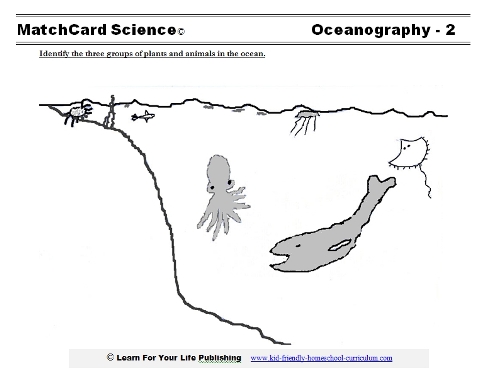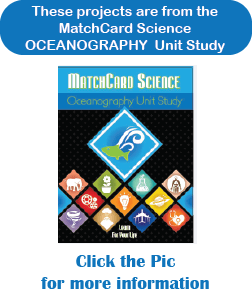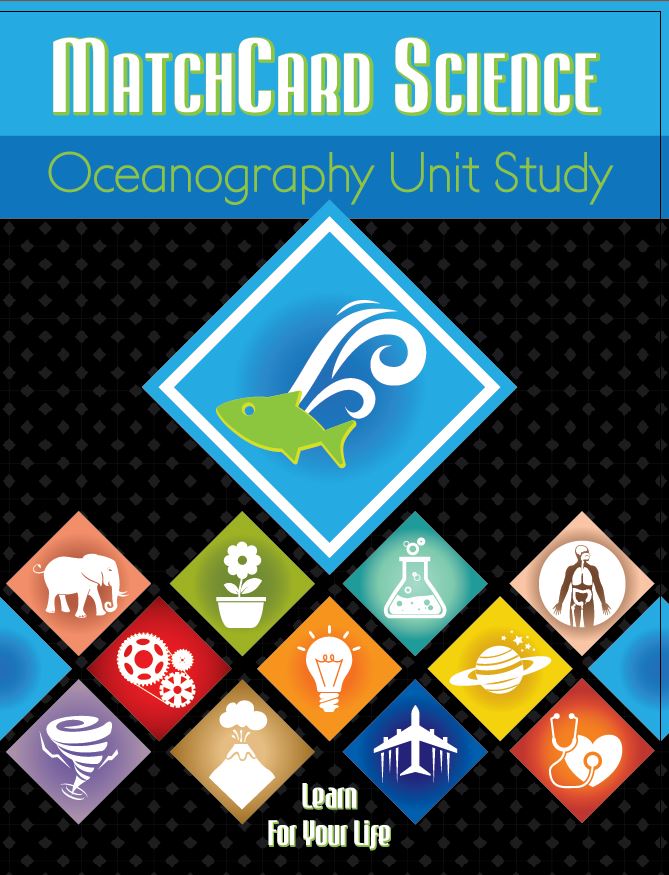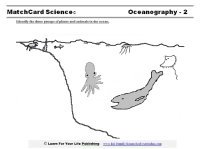Ocean Creatures
Investigate our ocean food chains
Discover the main groups of ocean creatures and the ocean food chain.
Free Download Below


Learn About Ocean Creatures
Objective: Identify the three main groups of plants and animals in the ocean.MatchCard: Download below.
MatchCard Information Pieces define and describe the following classes of ocean creatures:
- Plankton
- Benthos
- Nekton.
Ideas for projects are listed on the instructor's page and below.
Download and Use the Ocean Creatures MatchCard
This is MatchCard #2 of the Oceanography Unit Study. More information on the MatchCard Science curriculum is at the bottom of this page.Learn About the Ocean Food Web
Plankton
 Plankton are the plants and animals that drift on the top of the ocean. They include algae, protozoa, jellyfish, and the larvae of many sea animals.
Plankton are the plants and animals that drift on the top of the ocean. They include algae, protozoa, jellyfish, and the larvae of many sea animals.Plankton drift passively and are moved by ocean currents. They have no other means of movement.
Plankton make up the base of the ocean food web. All other forms of life are dependent on their existence.
In return, the plankton is dependent on the sun for survival. That is the reason these ocean creatures are only found at the top of the ocean zones.
Benthos
 Benthos are the ocean creatures that live on the ocean floor.
Benthos are the ocean creatures that live on the ocean floor.Benthos include seaweed, crabs, clams, lobsters, and sea urchins.
Some of the benthos, such as seaweed, are anchored to the ocean floor. Many of the animals in the group are able to move on their own legs. All of the sea life in the benthos group may be moved by ocean currents, but they are not passively dependent on it as the plankton are.
Coral reefs provide an amazing ecosystem of many types of benthos and nekton.
Nekton
 The nekton are the animals that swim in the ocean. This group includes fish, shark, whales, sting rays, and many other swimming animals.
The nekton are the animals that swim in the ocean. This group includes fish, shark, whales, sting rays, and many other swimming animals.Different nekton live at different ocean zones. Their diet may be made up of plankton, benthos, or other nekton.
I think the nekton are the most fascinating of the ocean creatures, though they are not the most numerous. And without the smaller, more humble plankton, their would be nekton at all.
Group Project: Ocean Food Chain
Ask each child to choose on plant or animal from each of the three groups. They need to look up information and present it for each of the three species they choose.If you have more than one student working on this project, have them write and/or draw their sea creature on an index card. Lay the different cards out on the floor in random order.
Let the students move the plankton to the top, and the benthos to the bottom.
Get a ball of yarn and scissors. Students can take turns cutting off a piece of yarn and laying it to connect to cards to show which animals eat other ocean creatures. Take turns making the connections so the ocean food web becomes a literal web on the floor.
Ocean Diorama
Make a poster or diorama of sea life. Include all of the ocean creatures the students choose to study. Use a centimeter or milimeter ruler to draw the different nekton to scale.Here are some ideas for making a diorama:
- Use a shoe box, and let the nekton dangle from string in the middle.
- Use a paper plate so it looks like you are looking out of a ship porthole.
Field Trip Time
A trip to the beach would be a great way to learn about the ocean first hand. Of course, if you happen to be 500 miles inland this just might not be a possibility.However, every area has lakes and ponds. If you can, observe the life on the top and bottom of the water. Make drawings of the three different groups.
Scoop some water into a cup. Let it settle, then look at it with a magnifying glass.
MatchCard Science
How To Use MatchCards

Download the FREE MatchCard Science Instructor's Guide and see how MatchCards can make building their science knowledge base fun.
Ocean Unit Study

12 Science Unit Studies

Chemistry is only one of twelve complete unit studies for kids in 3rd to 8th grade.
Comprehensive objectives, hands-on projects, suggested science fair experiments, and the fun game-like MatchCards keep them interested in learning science. See all twelve MatchCard Science Unit Studies.
About Our Site
Hands-On Learning















